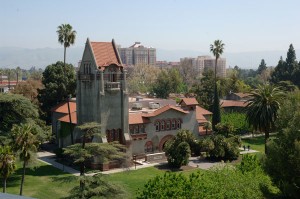
SJSU decided to focus on closing low enrollment electives in favor of high enrollment graduation requirements. It turns out that approximately 1,700 sections of the 5,000 sections offered annually had enrollments of less than 15 students.
By Pat Lopes Harris, Media Relations Director
For the first two weeks of each term, many SJSU students invest quite a bit of time in trying to drop and add classes in order to build a schedule that works. This is a difficult process, made even harder this year by budget cuts. Because state government support has dropped dramatically, resulting in an over $30 million budget deficit on our campus, SJSU is in the process of cutting a total of 500 sections this academic year, which equates to approximately 4.6 percent of the total. The process began during spring term, when the provost and deans started looking for ways to reduce the number of sections SJSU offers while minimizing the impact on the amount of time it takes for students to graduate.
SJSU decided to focus on closing low enrollment courses. It turns out that approximately 1,700 sections of the 5,000 sections offered during the fall had enrollments of less than 15 students. The provost, deans and department chairs made the cuts in a strategic manner, so that although SJSU is offering fewer sections this fall, the grand total for the number of seats offered in all sections has increased. In the future, SJSU will look for ways to continue to offer some of the cut courses, perhaps every other term, every other year, or by combining similar courses, with an emphasis on graduation requirements over electives.
Over the past week or so, the provost, deans and department chairs have been adding seats and sections as needed to “bottleneck” courses, which are classes required by many majors such as basic biology. You can get the latest numbers by going to the Office of Institutional Research website, and clicking on “Enrollment Planning.”
Provost Ellen Junn explained much of this at a forum held Sept. 5 in Morris Dailey Auditorium. Her presentation was taped, and you can watch it here.
How This Impacts Faculty
SJSU’s faculty is comprised of tenured and tenure-track professors, supplemented by part-time temporary lecturers on one- to three-year contracts. Many lecturers have taught at SJSU throughout their careers. Quite a few are working professionals who bring first-hand knowledge of their industries into the classroom, which is vital given the emphasis we place on applied learning. The value we place on lecturers for their contributions in the classroom and beyond is exemplified by our current Academic Senate Chair Beth Von Till, a lecturer in communications studies.
Reducing the number of sections means shifting the teaching workload from lecturers to professors. This results in less release time for professors pursuing special projects, and fewer opportunities for part-time temporary lecturers. How many faculty members do we have this fall compared to last fall? As of Aug. 30, we had 129 fewer lecturers this fall compared to one year ago. But because some lecturers work full time, while others work part time, it is also important to look at the numbers in terms of full time equivalents (FTEs). As of Aug. 30, SJSU had 60 fewer lecturer FTEs this fall compared to last fall.
Why Not Cut Other Divisions?
This is an important point, and one that bears further explanation and discussion. In particular, members of the university community and the media are focusing on the Office of the President, University Advancement and Athletics, which did not sustain cuts this year. President Mohammad Qayoumi addressed this at the Budget Forum held Sept. 10. You can watch it here.
More options to get info include attending provost’s forums and Academic Senate meetings, both of which are held monthly; discussing your concerns with members of Budget Advisory Task Force, listed on the SJSU Budget Central web site; and submitting suggestions by email. Please consider getting involved. It’s the best way to have a say and to understand the thinking behind the decisions intended to move our campus forward.

